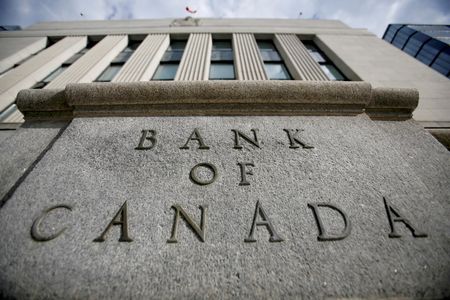By Steve Scherer and Fergal Smith
OTTAWA (Reuters) – The Bank of Canada has shifted to a less prescriptive messaging strategy than it used in January when it signaled a rate-hike pause that reignited the housing market, which added to inflation and the need to resume tightening five months later.
Last week after lifting rates to a 22-year high of 5.0%, Governor Tiff Macklem struck a more hawkish tone than when he announced a pause in January, warning the bank could hike again if economic data shows it is needed.
That switch could leave the BoC less vulnerable to criticism when forecasts go awry, leaving investors and borrowers to arrive at their own conclusions in assessing the outlook for interest rates.
“Every time (the members of the governing council) try to provide that hand-holding forward guidance, it doesn’t work,” said Derek Holt, vice president of capital markets economics at Scotiabank.
Central bankers around the world have underestimated inflation and grappled with communication. Macklem came under a rare attack last year from opposition politicians for misjudging inflation and locking in to a rigid forward guidance.
“We are turning the corner on inflation,” Macklem told reporters in January when the BoC became the first major central bank to announce a pause. “If economic developments and – in particular – if inflation comes down in line with our forecast, that will confirm that we have likely done enough.”
The markets quickly priced in a half-percentage-point in cuts by the end of the year, and the slumping housing market recovered. The average sale price of a home increased 19% between January and May, according to the Canadian Real Estate Association.
That jump in housing prices “is likely to persist and boost inflation by as much as 0.3 percentage points by the end of 2023, compared with the January outlook,” the BoC said last week.
‘IT MADE SENSE’
Last week, Macklem defended the decision.
“It made sense to pause,” he said, to assess the effect of the most rapid increase in rates in the BoC’s history. But then the economy outperformed the bank’s expectations, he added, which is something that has happened repeatedly in recent years.
The central bank’s tightening campaign is a major concern for Canadians who loaded up on cheap mortgages and took on credit card and other debt in recent years. Household debt as a proportion of disposable income rose to 184.5% in the first quarter, near a record high, which means there is C$1.85 in debt for every dollar of household disposable income.
Macklem did not use the word “pause” while announcing last week’s 25-basis-point hike, the second in as many months, though some analysts now expect the bank to do just that.
“Now maybe you’re getting a certain maturity of the central bank that says, ‘We’re not going to do that again,'” Holt said.
Though many economists are doubtful another rate hike is coming, money markets are still not shifting their bets toward a possible cut as they did in January, both because of the uncertainty of the inflation outlook and the bank’s threat to raise again if needed.
Macklem has delivered misleading messaging before.
He assured Canadians during the pandemic that rates would rise only in 2023 when it expected the economic slack to be absorbed, but the central bank began hiking rates in March 2022 as inflation spiked.
In October 2021, Macklem forecast inflation would return close to the central bank’s 2% target by the end of 2022, only to push back that goal in January of this year to end 2024. Last week, the bank further delayed that target to mid-2025.
Marc Chandler, chief market strategist at Bannockburn Global Forex LLC, said the fact that the BoC hiked not once, but twice starting in June after announcing the pause is evidence that it knew there was ground to be made up.
“The June hike wasn’t a one-off … it wasn’t just an insurance policy, but (a sign) they think that they made a mistake.”
(Reporting by Steve Scherer in Ottawa and Fergal Smith in Toronto; Editing by Denny Thomas and Matthew Lewis)





